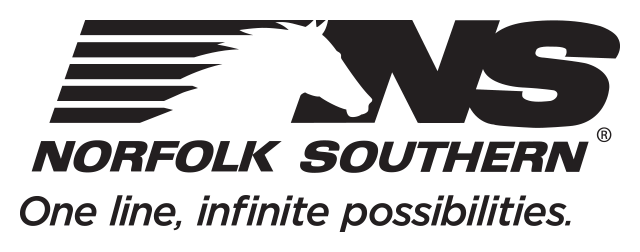New Corridor Terminals Anchor Long-Term Growth
The terminals complement regional facilities opened in 2012 on the corridor at Rossville, Tenn., near Memphis, and at McCalla, Ala., near Birmingham. Together, the four terminals provide capacity to remove more than 1 million long-haul trucks off of interstate highways across the 11-state corridor.
Charlotte Regional Intermodal Facility
The Charlotte facility replaced an existing 40-acre terminal near downtown that was overcrowded and lacked room to expand. To accommodate traffic at the old facility, the company operated a satellite parking lot about five miles away, unloading containers from trains and draying them to the lot for pickup. This process was costly, consumed time, and made it more difficult to compete with trucks for long-haul freight.
The new terminal, uniquely situated between runways at the Charlotte Douglas International Airport, has ample space for growth and truck-competitive service. It covers 200 acres and offers three loading tracks, more than 1,300 parking spaces, and the capability of 200,000 container lifts annually. Located near Interstate 485, the terminal is easily accessible to short-haul truckers making last-mile pickups and drop-offs for customers, reducing congestion and unnecessary emissions caused by stalled traffic and idling trucks.
Much of the business at the new Charlotte terminal is transcontinental freight moving to and from Texas markets, the West Coast, and Mexico.
“This intermodal facility is projected to bring billions in business, and places Charlotte even more in the manufacturing, distribution, transportation, and economic growth business.”
ANTHONY FOXX, former Charlotte mayor and current U.S. Secretary of Transportation, speaking at the May 2012 groundbreaking of the new Charlotte terminal
Franklin County Regional Intermodal Facility
Located in Greencastle in south central Pennsylvania, the 200-acre Franklin County facility places Norfolk Southern into a new market that serves as a freight gateway in the mid-Atlantic region. The terminal complements existing intermodal facilities at Harrisburg and Rutherford, Pa., providing an additional option for customers in southeastern Pennsylvania, western Maryland, and northern Virginia to connect with domestic and world markets.
The facility, less than a mile from Interstate 81, has 670 trailer and container parking spots. For some customers, the new terminal reduces the length of truck drayage, one of the biggest shipping expenses, offering customers a more affordable option and the possibility to remove trucks from I-81.
Rail traffic through the terminal moves north and south and runs to such markets as Memphis, Tenn., Charlotte, N.C., and Atlanta. Greencastle also serves as an anchor for freight moving to and from Mexico. Its opening was key to our ability in early 2013 to begin offering 18 new service lanes to three regional Mexican markets, including business in auto parts and appliances. Other product moving through the terminal includes paper, plastic, and food products.
Markets served include Baltimore, Perryville, Eldersburg, and Frederick in Maryland; Carlisle, Mechanicsburg, and York in Pennsylvania; and Raphine, Winchester, and Covington in Virginia.
“These facilities are proven centers of business growth, and I am sure it will create many opportunities for Franklin County and the region. I have long supported freight rail because of its efficiency and see this terminal as a vital infrastructure improvement.”
U.S. Rep. BUD SHUSTER, chairman of the U.S. House Committee on Transportation and Infrastructure“Since the facility opened, more than 2 million square feet of new construction has commenced in Franklin County, that when completed will lead to more than 1,000 new jobs.”
MIKE ROSS, president of the Franklin County Area Development Corporation“Freight rail is perhaps the most cost-effective, fuel-efficient, and environmentally sensible mode of freight transportation available to us today. Investing in freight rail infrastructure projects like these will encourage job growth, improve our local and national economies, and provide tremendous environmental benefits.”
Pennsylvania state Sen. RICH ALLOWAY
Crescent Terminals Are Efficient, Speedy, and Green
All four of the new regional intermodal facilities constructed on the Crescent Corridor are designed for ease of business and minimal environmental impact. That includes use of high-tech systems and low-emissions equipment.
FEATURES INCLUDE:
- Automated gate systems outfitted with digital cameras and scanners. These systems speed the flow of drayage truckers moving in and out of the terminals to drop off or pick up intermodal containers or trailers. The AGS systems improve driver productivity while reducing idling, emissions, and fuel costs.
- Low-emission cranes to move containers on and off trains. The rubber tire gantry cranes at our new terminals at Charlotte and Greencastle, for example, feature power-on-demand technology that automatically adjusts diesel engine power to load demands, resulting in fuel savings of 36 percent, according to the manufacturer. Our Birmingham Regional Intermodal Terminal in McCalla, Ala., is using a new type of battery-powered hybrid RTG crane, which consumes about two-thirds less fuel than do standard diesel cranes.
- Administration buildings constructed to Leadership in Energy and Environmental Design, or LEED, standards to reduce environmental footprint. The buildings feature LEED best practices, including “low-impact” construction materials such as light-colored metal “cool” roofs that reflect heat, low-flow plumbing fixtures, and high-efficiency heating and cooling units. In addition, windows are arranged to make better use of sunlight, while extended roof overhangs act as sun shades to reduce air-conditioning use.
THE LEED STAMP OF APPROVAL
In 2013 and early 2014, the U.S. Green Building Council officially certified that the administration buildings at Norfolk Southern’s regional intermodal facilities at McCalla, Ala., and Rossville, Tenn., opened in 2012, meet the best-practice standards of Leadership in Energy and Environmental Design.
“LEED certification underscores Norfolk Southern’s commitment to a sustainable business strategy benefiting our customers and the communities we serve,” said Blair Wimbush, our vice president real estate and corporate sustainability officer.
New terminal facilities opened in 2013 in Charlotte, N.C., and Greencastle, Pa., also incorporate LEED design standards, but have not yet received official certification.




